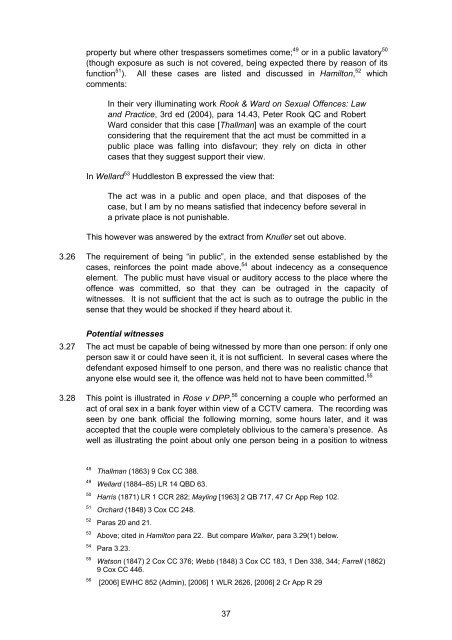public nuisance and outraging public decency - Law Commission
public nuisance and outraging public decency - Law Commission
public nuisance and outraging public decency - Law Commission
Create successful ePaper yourself
Turn your PDF publications into a flip-book with our unique Google optimized e-Paper software.
property but where other trespassers sometimes come; 49 or in a <strong>public</strong> lavatory 50<br />
(though exposure as such is not covered, being expected there by reason of its<br />
function 51 ). All these cases are listed <strong>and</strong> discussed in Hamilton, 52 which<br />
comments:<br />
In their very illuminating work Rook & Ward on Sexual Offences: <strong>Law</strong><br />
<strong>and</strong> Practice, 3rd ed (2004), para 14.43, Peter Rook QC <strong>and</strong> Robert<br />
Ward consider that this case [Thallman] was an example of the court<br />
considering that the requirement that the act must be committed in a<br />
<strong>public</strong> place was falling into disfavour; they rely on dicta in other<br />
cases that they suggest support their view.<br />
In Wellard 53 Huddleston B expressed the view that:<br />
The act was in a <strong>public</strong> <strong>and</strong> open place, <strong>and</strong> that disposes of the<br />
case, but I am by no means satisfied that in<strong>decency</strong> before several in<br />
a private place is not punishable.<br />
This however was answered by the extract from Knuller set out above.<br />
3.26 The requirement of being “in <strong>public</strong>”, in the extended sense established by the<br />
cases, reinforces the point made above, 54 about in<strong>decency</strong> as a consequence<br />
element. The <strong>public</strong> must have visual or auditory access to the place where the<br />
offence was committed, so that they can be outraged in the capacity of<br />
witnesses. It is not sufficient that the act is such as to outrage the <strong>public</strong> in the<br />
sense that they would be shocked if they heard about it.<br />
Potential witnesses<br />
3.27 The act must be capable of being witnessed by more than one person: if only one<br />
person saw it or could have seen it, it is not sufficient. In several cases where the<br />
defendant exposed himself to one person, <strong>and</strong> there was no realistic chance that<br />
anyone else would see it, the offence was held not to have been committed. 55<br />
3.28 This point is illustrated in Rose v DPP, 56 concerning a couple who performed an<br />
act of oral sex in a bank foyer within view of a CCTV camera. The recording was<br />
seen by one bank official the following morning, some hours later, <strong>and</strong> it was<br />
accepted that the couple were completely oblivious to the camera’s presence. As<br />
well as illustrating the point about only one person being in a position to witness<br />
48 Thallman (1863) 9 Cox CC 388.<br />
49 Wellard (1884–85) LR 14 QBD 63.<br />
50 Harris (1871) LR 1 CCR 282; Mayling [1963] 2 QB 717, 47 Cr App Rep 102.<br />
51 Orchard (1848) 3 Cox CC 248.<br />
52 Paras 20 <strong>and</strong> 21.<br />
53 Above; cited in Hamilton para 22. But compare Walker, para 3.29(1) below.<br />
54 Para 3.23.<br />
55<br />
Watson (1847) 2 Cox CC 376; Webb (1848) 3 Cox CC 183, 1 Den 338, 344; Farrell (1862)<br />
9 Cox CC 446.<br />
56 [2006] EWHC 852 (Admin), [2006] 1 WLR 2626, [2006] 2 Cr App R 29<br />
37

















